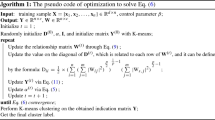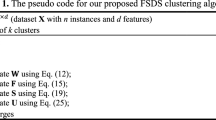Abstract
Redundant features and outliers (noise) included in the data points for a machine learning clustering model heavily influences the discovery of more distinguished features for clustering. To solve this issue, we propose a spectral new clustering method to consider the feature selection with the \(L_{2,1}\)-norm regularization as well as simultaneously learns orthogonal representations for each sample to preserve the local structures of data points. Our model also solves the issue of out-of-sample, where the training process does not output an explicit model to predict unseen data points, along with providing an efficient optimization method for the proposed objective function. Experimental results showed that our method on twelve data sets achieves the best performance compared with other similar models.



Similar content being viewed by others
References
Zhu X, Goldberg AB (2009) Introduction to semi-supervised learning. Synth Lect Artif Intell Mach Learn 3(1):1–130
Berkhin P (2006) A survey of clustering data mining techniques. In: Kogan J (ed) Grouping multidimensional data. Springer, Berlin, pp 25–71
Bodea CN, Dascalu MI, Lipai A (2012) Clustering of the web search results in educational recommender systems. In: Olga C (ed) Educational recommender systems and technologies: practices and challenges. IGI Global, Pennsylvania, pp 154–181
Fabrizio C et al (2018) 4.2 Paper V: application of data clustering to railway delay pattern recognition. In: Analytical, big data, and simulation models of railway delays, pp 121
Li H, He X, Tao D, Tang Y, Wang R (2018) Joint medical image fusion, denoising and enhancement via discriminative low-rank sparse dictionaries learning. Pattern Recognit 79:130–146
Zhu X, Zhang S, Li Y, Zhang J, Yang L, Fang Y (2018) Low-rank sparse subspace for spectral clustering. IEEE Trans Knowl Data Eng 31:1532–1543
Zhu Y, Zhong Z, Cao W, Cheng D (2016) Graph feature selection for dementia diagnosis. Neurocomputing 195:19–22
Li X, Li X, Ma H (2020) Deep representation clustering-based fault diagnosis method with unsupervised data applied to rotating machinery. Mech Syst Sig Process 143:106825
Jain AK (2010) Data clustering: 50 years beyond k-means. Pattern Recognit Lett 31(8):651–666
Chan PK, Schlag MDF, Zien JY (1994) Spectral k-way ratio-cut partitioning and clustering. IEEE Trans Comp-Aided Des Integr Circuits Syst 13(9):1088–1096
Li Z, Chen J (2015) Superpixel segmentation using linear spectral clustering. In: Proceedings of the IEEE Conference on Computer Vision and Pattern Recognition, pp 1356–1363
Yan Y, Liu G, Wang S, Zhang J, Zheng K (2017) Graph-based clustering and ranking for diversified image search. Multimed Syst 23(1):41–52
Bunke H, Riesen K (2011) Improving vector space embedding of graphs through feature selection algorithms. Pattern Recognit 44(9):1928–1940
Peng X, Yu Z, Yi Z, Tang H (2017) Constructing the l2-graph for robust subspace learning and subspace clustering. IEEE Trans Cybern 47(4):1053–1066
He W, Zhu X, Cheng D, Hu R, Zhang S (2017) Low-rank unsupervised graph feature selection via feature self-representation. Multimed Tools Appl 76(9):12149–12164
Zhao Z, He X, Cai D, Zhang L, Ng W, Zhuang Y (2015) Graph regularized feature selection with data reconstruction. IEEE Trans Knowl Data Eng 28(3):689–700
Wang S, Zhu W (2018) Sparse graph embedding unsupervised feature selection. IEEE Trans Syst Man Cybern Syst 48(3):329–341
Guyon I, Elisseeff A (2003) An introduction to variable and feature selection. J Mach Learn Res 3(Mar):1157–1182
Inoue A, Kilian L (2005) In-sample or out-of-sample tests of predictability: Which one should we use? Econom Rev 23(4):371–402
Zhu P, Zuo W, Zhang L, Hu Q, Shiu SCK (2015) Unsupervised feature selection by regularized self-representation. Pattern Recognit 48(2):438–446
Vural E, Guillemot C (2016) Out-of-sample generalizations for supervised manifold learning for classification. IEEE Trans Image Process 25(3):1410–1424
Zhuang L, Gao H, Lin Z, Ma Y, Zhang X, Yu N (2012) Non-negative low rank and sparse graph for semi-supervised learning. In: 2012 IEEE Conference on Computer Vision and Pattern Recognition, pp 2328–2335. IEEE
Lu X, Wang Y, Yuan Y (2013) Graph-regularized low-rank representation for destriping of hyperspectral images. IEEE Trans Geosci Remote Sens 51(7):4009–4018
Li W, Liu J, Du Q (2016) Sparse and low-rank graph for discriminant analysis of hyperspectral imagery. IEEE Trans Geosci Remote Sens 54(7):4094–4105
Kuang D, Yun S, Park H (2015) Symnmf: nonnegative low-rank approximation of a similarity matrix for graph clustering. J Glob Optim 62(3):545–574
Nie F, Huang H, Cai X, Ding CH (2010) Efficient and robust feature selection via joint l2, 1-norms minimization. In: Avances in neural information processing systems, pp 1813–1821
West DB et al (1996) Introduction to graph theory, vol 2. Prentice hall, Upper Saddle River, NJ
Hogstedt K, Kimelman D, Rajan VT, Roth T, Wegman M (2001) Graph cutting algorithms for distributed applications partitioning. ACM SIGMETRICS Perform Evaluat Rev 28(4):27–29
Nie F, Wang X, Jordan MI, Huang H (2016) The constrained laplacian rank algorithm for graph-based clustering. In: hirtieth AAAI Conference on Artificial Intelligence
Nie F, Wang H, Deng C, Gao X, Li X, Huang H (2016) New l1-norm relaxations and optimizations for graph clustering. In: Thirtieth AAAI Conference on Artificial Intelligence
Peng X, Yu Z, Yi Z, Tang H (2016) Constructing the l2-graph for robust subspace learning and subspace clustering. IEEE Trans Cybern 47(4):1053–1066
Lee DD, Seung HS (2001) Algorithms for non-negative matrix factorization. In: Advances in neural information processing systems, pp 556–562
Yin M, Gao J, Lin Z (2015) Laplacian regularized low-rank representation and its applications. IEEE Trans Pattern Anal Mach Intell 38(3):504–517
Fang X, Xu Y, Li X, Lai Z, Wong WK (2015) Learning a nonnegative sparse graph for linear regression. IEEE Trans Image Process 24(9):2760–2771
Zhu X, Li X, Zhang S, Xu Z, Yu L, Wang C (2017) Graph pca hashing for similarity search. IEEE Trans Multimed 19(9):2033–2044
Shahid N, Perraudin N, Kalofolias V, Puy G, Vandergheynst P (2016) Fast robust pca on graphs. IEEE J Sel Top Sig Process 10(4):740–756
Feng CM, Gao YL, Liu JX, Zheng CH, Yu J (2017) Pca based on graph laplacian regularization and p-norm for gene selection and clustering. IEEE Trans Nanobiosci 16(4):257–265
Chen F, Wang B, Kuo CCJ (2019) Deepwalk-assisted graph pca (dgpca) for language networks. In: ICASSP 2019-2019 IEEE International Conference on Acoustics, Speech and Signal Processing (ICASSP), pp 2957–2961. IEEE
Montanari A (2015) Finding one community in a sparse graph. J Statist Phys 161(2):273–299
Pedarsani R, Yin D, Lee K, Ramchandran K (2017) Phasecode: fast and efficient compressive phase retrieval based on sparse-graph codes. IEEE Trans Inf Theory 63(6):3663–3691
Wang S, Zhu W (2016) Sparse graph embedding unsupervised feature selection. IEEE Trans Syst Man Cybern Syst 48(3):329–341
Xue Z, Du P, Li J, Su H (2015) Simultaneous sparse graph embedding for hyperspectral image classification. IEEE Trans Geosci Remote Sens 53(11):6114–6133
Li X, Cui G, Dong Y (2017) Graph regularized non-negative low-rank matrix factorization for image clustering. IEEE Trans Cybern 47(11):3840–3853
Zhuang L, Gao S, Tang J, Wang J, Lin Z, Ma Y, Yu N (2015) Constructing a nonnegative low-rank and sparse graph with data-adaptive features. IEEE Trans Image Process 24(11):3717–3728
Li S, Fu Y (2015) Learning balanced and unbalanced graphs via low-rank coding. IEEE Trans Knowl Data Eng 27(5):1274–1287
Yang Y, Shen HT, Nie F, Ji R, Zhou X (2011) Nonnegative spectral clustering with discriminative regularization. In: Twenty-Fifth AAAI Conference on Artificial Intelligence
Von Luxburg U (2007) A tutorial on spectral clustering. Statist Comput 17(4):395–416
Soltanolkotabi M, Elhamifar E, Candes EJ et al (2014) Robust subspace clustering. Ann Statist 42(2):669–699
Vidal R (2011) Subspace clustering. IEEE Sig Process Mag 28(2):52–68
Yang Y, Ma Z, Yang Y, Nie F, Shen HT (2014) Multitask spectral clustering by exploring intertask correlation. IEEE Trans Cybern 45(5):1083–1094
Roweis ST, Saul LK (2000) Nonlinear dimensionality reduction by locally linear embedding. Science 290(5500):2323–2326
Kang Z, Peng C, Cheng Q, Xu Z (2018) Unified spectral clustering with optimal graph. In: Thirty-Second AAAI Conference on Artificial Intelligence
Li Z, Yang Y, Liu J, Zhou X, Lu H (2012) Unsupervised feature selection using nonnegative spectral analysis. In: Twenty-Sixth AAAI Conference on Artificial Intelligence
Pang Y, Yuan Y (2010) Outlier-resisting graph embedding. Neurocomputing 73(4–6):968–974
Nie F, Zhang R, Li X (2017) A generalized power iteration method for solving quadratic problem on the stiefel manifold. Sci China Inf Sci 60(11):112101
Dodge Y (2012) Statistical data analysis based on the L1-norm and related methods. Birkhäuser, Basel
Kloft M, Brefeld U, Laskov P, Sonnenburg S (2008) Non-sparse multiple kernel learning. In: NIPS Workshop on Kernel Learning: Automatic Selection of Optimal Kernels
Elhamifar E, Vidal R (2013) Sparse subspace clustering: algorithm, theory, and applications. IEEE Trans Pattern Anal Mach Intell 35(11):2765–2781
Liu G, Lin Z, Yan S, Sun J, Yu Y, Ma Y (2012) Robust recovery of subspace structures by low-rank representation. IEEE Trans Pattern Anal Mach Intell 35(1):171–184
Nie F, Zhu W, Li X (2017) Unsupervised large graph embedding. In: Thirty-first AAAI conference on artificial intelligence
Author information
Authors and Affiliations
Corresponding author
Additional information
Publisher's Note
Springer Nature remains neutral with regard to jurisdictional claims in published maps and institutional affiliations.
Rights and permissions
About this article
Cite this article
Zhu, J., Jang-Jaccard, J., Liu, T. et al. Joint Spectral Clustering based on Optimal Graph and Feature Selection. Neural Process Lett 53, 257–273 (2021). https://doi.org/10.1007/s11063-020-10383-9
Accepted:
Published:
Issue Date:
DOI: https://doi.org/10.1007/s11063-020-10383-9




